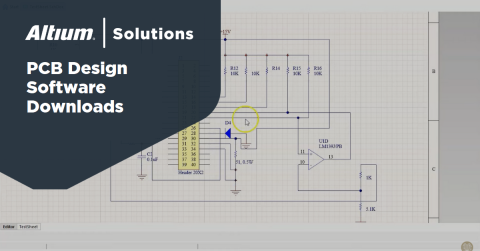The Advantages and Disadvantages of Designing with Breadboards
Breadcrumbs, breadboards, and breadwinners. One of which has electronic components. Two of which will provide you with a delicious and nutritious meal enough to feed a family. The first, will provide you with the foundational playground to which your printed circuit board board design will spawn from. I will save you time, effort, and many awkward encounters by telling you that if you go around trying to stick jumper leads into breadwinners around town, your design will most likely not succeed.
Similarly, you will likely not maintain proper signal integrity amongst other issues if you try to route your CPU through a mountain of breadcrumbs. Let’s leave the questions behind and conclude that breadboards are what you use for your PCB design. All jokes aside, breadboards are likely going to be in the desk drawer of every printed circuit board and will likely be the first place you will turn when in need of a sandbox style domain for you to test your new designs on.
But some questions will remain even for the seasoned designers. Is it appropriate to use a breadboard for every design application? Are there limits to what these wonderful contraptions can do? Can similar prototyping challenges be accomplished via computer simulation? Do you need an Arduino compatible breadboard? Learning about the advantages and disadvantages of breadboard to understand the capabilities of a breadboard diagram. This is important because once understood, you can determine if using one is best for your design needs.
What Advantages Do Breadboards Have?
It may appear that the limits these boards have are enough to send you running for greener pastures, however, the advantages the boards carry will likely be ample for any designer to at least consider.
The ease with which you can change a breadboard is one of its biggest benefits. Imagine you have a rock-solid design all drawn out and soldered up, only to find that there is a bug buried deep within the system. A long and messy road of a solderless breadboard and debugging is in your future. Now if you were to wire up your design with the removable and easily adjustable jumper wires, this design fix would be a seamless event of unplugging and replugging.
Additionally, if your rock-solid design and component was to be soldered up, ready to go, but then failed in a catastrophic way (cue mini explosion noises), your entire circuit board may be in jeopardy and you’ll potentially be out of otherwise perfectly functional component. With the breadboard acting as a sort of shield for your (hopefully non-) failing systems, you can ensure that portions of your design will remain intact.
What Limits Do Breadboards Have?
Originally, breadboards were in fact as they sound to be; a board in which bread was cut on. These wooden boards were easy-to-access, and inexpensive way to mount your electrical projects on. As they began to develop the first true electrical boards, the term was just too commonly used with electronics to be abandoned, thus remained the term “breadboard.” So aside from the fact that modern breadboards aren’t viable tools to cut your delicious sourdough on, there are a few other limitations that exist that must be taken into account when determining your next prototyping steps.
Breadboard diagrams will not be a good tool when working with a circuit design with with high voltage. Although most Printed Circuit Board manufacturing applications deal in low-voltage applications, if you find yourself in the area of 50V, pay attention and consider the fact that the board connections are not suited for this voltage application. Similarly, the board and component will have difficulty in keeping up with high current applications. When heading into 20mA’s or greater, you will likely find your design not performing as well.
In addition, when dealing with frequencies in the higher, more precise reaches of the spectrum, your signal integrity will certainly be in jeopardy and will not easily travel through the board. The reason for most of the errors you will run into with signal integrity (as well as the aforementioned disadvantages) is due mainly to the physical connection strips within the boards. These strips carry a very high resistance and can, in turn, carry stray capacitance that may wreak havoc.
What Alternatives Are There To Breadboards?
We’ve moved from the original boards back in the days of cutting our bread atop our circuit design to physical copper strips integrated within the board, but what’s the next step in breadboard prototyping? Some simulated programs mimic what breadboards aim to accomplish but will not run you the labor of setting up the circuit design (in a physical sense). Limitations of these programs are not nearly as lengthy as a physical board.
As long as the ability is written into each simulator, you can test and simulate to your heart's desire. The only caveat of these programs is the learning curve associated with each, and each likely has its own degree of difficulty.
Aside from the benefits of augmenting my physical board arrangements via interactive visual CAD simulation software, I personally enjoy seeing a physical mock-up of my circuit design prior to any finished solder mask layer of a printed circuit design. It gives me a real world, real functioning mock-up for me to physically hold and feel. This, of course, is my own preference and will highly depend on what my PCB design aims to accomplish, but nothing beats a circuit design constructed with my own two hands.
A program that encompasses features such as Design Verification which allow you to simulate your circuit design under a vast array of variables in order to test for flaws and inconsistencies without ever setting foot in a lab setting. A very powerful tool that may save you many headaches (from the plume of blown caps your rock-solid circuit design may run through). If you’re looking for a rigid-flex PCB design software with this and other prime features, consider Altium Designer®.
Knowing what we know now, where does your design stack up to when considering breadboard advantages and disadvantages? If you are still questioning the benefits, limitations, and simulated alternatives relative to your design, talk to an Altium Designer expert today.


















